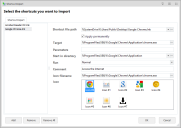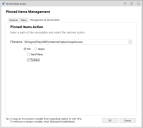Environment Manager
This page refers to an older version of the product.
View the current version of the User Help.
Shortcut Actions
When triggered, these actions create shortcuts on managed endpoints. The shortcuts can be those that are created in Windows Explorer or those that are pinned to the Windows Start menu or taskbar.
In this section:
- Create a Shortcut Action
- Import Multiple Shortcuts
- Create a Pinning Action
- Shortcut Management for Roaming Users
Create a Shortcut Action
- Configure an action to create a shortcut on endpoints.
- In the Policy Configuration navigation tree, select or create a node or condition.
- In the Actions ribbon, select Shortcut > Shortcut Management to display the Shortcut Management dialog.
- Select whether the action will Create or Delete a shortcut from endpoints.
- In the Shortcut file path field, use the ellipsis to navigate to the required shortcut or enter the path and filename.
-
Select whether the shortcut remains on managed endpoints after log off. The default setting is Apply Permanently. Deselect this option to remove shortcuts from managed endpoints at logoff.
The following fields are automatically populated from the Shortcut file path but you can edit them if required:
- Target - The location of the program that the shortcut accesses.
- Parameters - Define further parameters for the target program. For example, the program could be Microsoft Word. If you enter a particular document in the target parameters, that document will open in Word.
- Start in Directory - The working directory of the program.
- Run - Select whether the associated program should open, maximized, minimized, or using the default view.
- Comment - The text that displays when you hover over the shortcut icon.
- Icon Filename - The location of the shortcut icon.
- Icon - The icon used for the shortcut.
- Click OK
to save the action.
See also Configuring Actions in the Action Management help.
Import Multiple Shortcuts
- Import existing shortcuts into the wizard to create multiple shortcuts on managed endpoints.
- Select or create a node or condition.
- From the Actions ribbon, click Shortcut > Import Shortcut Wizard.
- Click Add.
-
Select a shortcut file (LNK format).
The remaining fields are automatically populated and you can edit them as required.
- Select whether the shortcut remains on managed endpoints after logoff. Shortcuts created though Environment Manager are automatically removed from endpoints at logoff unless you select Apply Permanently.
- Click Add to add more shortcuts. To remove shortcuts, either select and click Remove or click Remove All.
- Click OK.
Each shortcut listed creates an individual Create Shortcut action in the work area.
Create a Pinned Items Action
Pin or unpin applications to the Windows Start menu or taskbar on managed endpoints. The action compares the existing pinned items on endpoints against the items that the action is configured to pin.
- Select or create a node or condition on the Pre-Desktop trigger.
- On the Actions ribbon, select Shortcut > Pinned Items Action.
-
Enter the path, or navigate to, the executable for the required application.
Shortcuts with parameters cannot be pinned. For example, notepad.exe can be pinned but notepad.exe abc.txt cannot.
Executables with switches cannot be pinned. For example, an application with the /prefetch:# switch cannot be pinned.
- Select whether to Pin or Unpin the application.
- Select whether the action applies to the Start Menu or the Taskbar.
- Click OK
to save the action.
See also Configuring Actions in the Action Management help.
Shortcut Management for Roaming Users
As a user moves between managed endpoints with different operation systems and applications, some configured shortcuts are not valid for all environments. When this happens, Environment Manager manages the following temporarily invalid shortcuts:
| Shortcut or Link | Supported Operating System |
|---|---|
| Standard shortcuts in the Windows file system that point to a target does not exist | All supported operating systems |
| Items pinned to the taskbar that point to nonexistent paths | All supported operating systems |
| Items pinned to the Start menu that point to nonexistent paths | Windows 7, Windows Server 2008 R2 |
Environment Manager either hides the temporarily invalid shortcuts or - if possible - resolves the links to point to an equivalent path, such as when a user moves between 32-bit and 64-bit environments. If items pinned to the taskbar or Start menu are removed, the order of the pinned items is retained. When a user returns to an environment where the shortcuts are valid, the shortcuts and pinned items - and the order in which they are arranged - are restored.


